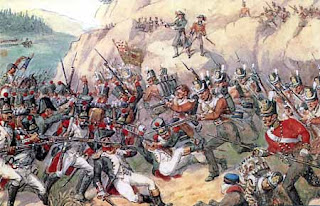 When I read Janet’s comment on Megan’s Calgon, Take Me Away post about how the English behaved when out of their familiar milieu, it reminded me of some episodes I’d read about in my favorite go-to book on army life, LIFE IN WELLINGTON’S ARMY by Antony Brett-James. For many in the British Army, the Peninsular War was their first exposure to new countries, languages and customs and all sorts of fun ensued.
When I read Janet’s comment on Megan’s Calgon, Take Me Away post about how the English behaved when out of their familiar milieu, it reminded me of some episodes I’d read about in my favorite go-to book on army life, LIFE IN WELLINGTON’S ARMY by Antony Brett-James. For many in the British Army, the Peninsular War was their first exposure to new countries, languages and customs and all sorts of fun ensued.
(Note: The picture is from THE WHEATLEY DIARY captioned ‘There is a national peculiarity in their manner of dressing.’)
Some conscientious officers studied Portuguese and Spanish en route to the Peninsula and some hired local teachers but some never did acquire any fluency. Consider this tale:
One commissary, perplexed to know how to convey his meaning to a party of muleteers, eventually turned to some British officers standing nearby and asked if anyone could help. One officer immediately stepped forward. ‘I think, sir, that I can explain to them anything you need.’ The commissary was delighted. ‘Then, sir, be so kind as to tell them that they must be here early in the morning with their mules.’
The interpreter addressed the puzzled muleteers as follows: ‘Portuguesios, the commissario – wants the mulos – tomorrowo – presto – la, al,’ and pointed to the village of Vimeiro. ‘Oh, sir!’ cried the commissary, who was very disappointed by this ludicrous performance, ‘I feel much obliged to you, but I can go as far as that myself.’ For months after this episode the self-styled linguist bore the nickname of ‘Jack the Interpreter’.
Food could be a problem, especially since the British were not accustomed to garlic.
Major Berkeley Paget had his breath taken away near Corunna in 1808 when ‘a sausage as large as a line-of-battleship’s mainyard, cram full of garlic, a dish of macaroni poisoned with saffron, and a salad mixed with lamp-oil’ were placed on the dining table. As Paget was a guest, he felt obliged to eat it all out of politeness, and to lie through thick and thin by saying he found it delightful.
“Poisoned” with saffron? Garlicky? This meal sounds yummy to me, with the possible exception of the lamp-oil. Maybe it was actually olive oil?
 And then they had to adjust to local customs and manners. Some, like Captain Pocock of the Highland Light Infantry, had the following observation on seeing the fandango danced.
And then they had to adjust to local customs and manners. Some, like Captain Pocock of the Highland Light Infantry, had the following observation on seeing the fandango danced.
‘This dance had a great effect upon us, but the Spaniards saw it without being moved, and laughed at the quick breathing and amorous looks of our men.’
Or how about this anecdote?
“Woodberry, writing in Olite during August 1813, noted another custom of Spanish women that struck an Englishman as indecent. If you had your back to a woman and she wanted to attract your attention, she would not tap you on the shoulder; instead she was likely to give you several hefty smacks on the bottom. Woodberry himself was greeted in this fashion one morning in the market place and everybody roared with laughter at his embarrassment.”
I must find a way to put that in a story! 🙂
I have been to Norway, France and Italy myself, but I had my most embarrassing culture shock moments while living in England, maybe because I expected things to be more similar. My first day at work there, I ordered zucchini and got the most blank look from the server. Finally, I pointed and she said, “Oh, courgettes.”
And then there was the first trip to a movie theatre, ordering popcorn and discovering that it was sprinkled with sugar, not salt. It’s not unpleasant but a big surprise when you’re not expecting it!
And a hint to anyone traveling to England: do NOT call those little pouches people wear on belts fanny packs! 🙂
Have you had any awkward culture shock moments? Are you like me in enjoying stories that pull characters out of their usual element?
Elena
www.elenagreene.com
P.S. Don’t forget to send your LOLRegencies to RISKIES@YAHOO.COM by midnight EST tonight, for the chance to win a copy of Janet’s THE RULES OF GENTILITY!
 Some of my favorites include the duct tape episodes (they even built a boat out of it) and the one where they (sadly!) proved that Captain Kirk could not have built a bamboo cannon to defeat his Gorn Opponent in the “Arena” episode. Star Trek and black powder—what’s not to love?
Some of my favorites include the duct tape episodes (they even built a boat out of it) and the one where they (sadly!) proved that Captain Kirk could not have built a bamboo cannon to defeat his Gorn Opponent in the “Arena” episode. Star Trek and black powder—what’s not to love?
 Mythbusters has boards on www.discovery.com where one can submit new myths. In the historical myths section, I found someone has posted something similar related to the American Civil War, so I added this Napoleonic bit to that thread. It would be fun to see this one tested!
Mythbusters has boards on www.discovery.com where one can submit new myths. In the historical myths section, I found someone has posted something similar related to the American Civil War, so I added this Napoleonic bit to that thread. It would be fun to see this one tested!









